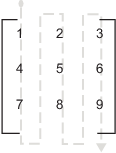Data Handling with TLC
Matrix Parameters
MATLAB®, Simulink®, and the code generator use column-major ordering for array storage (1-D, 2-D,
...). The next element of an array in memory is accessed by incrementing the first index of
the array. For example, these element pairs are stored sequentially in memory:
A(i) and A(i+1), B(i,j) and
B(i+1,j), C(i,j,k) and
C(i+1,j,k). For more information on the internal representation of
MATLAB data, see MATLAB Data.
Code Generator Matrix Parameters
Simulink and code generator internal data storage formatting differs from MATLAB internal data storage formatting only in the storage of complex number arrays. In MATLAB, the real and imaginary parts are stored in separate arrays. In the Simulink and code generator products they are stored in an "interleaved" format, where the numbers in memory alternate real, imaginary, real, imaginary, and so forth. This convention allows efficient implementations of small signals on Simulink lines and for Mux blocks and other "virtual" signal manipulation blocks (that is, they do not actively copy their inputs, merely the references to them).
The compiled model file, model.rtw.rtw file and paste it into MATLAB code
and have it recognized by MATLAB.
TLC declares Simulink block matrix parameters as scalar or 1-D array variables
real_T scalar; real_T mat[ nRows * nCols ];
where real_T can be an arbitrary data type supported by Simulink, and match the variable type given in the model file.
For example, the 3-by-3 matrix in the Look-Up Table (2-D) block
1 2 3 4 5 6 7 8 9
is stored in model.rtw
Parameter {
Name "OutputValues"
Value Matrix(3,3)
[[1.0, 2.0, 3.0]; [4.0, 5.0, 6.0]; [7.0, 8.0, 9.0];]
String "t"
StringType "Variable"
ASTNode {
IsNonTerminal 0
Op SL_NOT_INLINED
ModelParameterIdx 3
}
}and results in this definition in model.h
typedef struct Parameters_tag {
real_T s1_Look_Up_Table_2_D_Table[9];
/* Variable:s1_Look_Up_Table_2_D_Table
* External Mode Tunable:yes
* Referenced by block:
* <S1>/Look-Up Table (2-D
*/
[ ... other parameter definitions ... ]
} Parameters;The model.h

Parameters model_P = {
/* 3 x 3 matrix s1_Look_Up_Table_2_D_Table */
{ 1.0, 4.0, 7.0, 2.0, 5.0, 8.0, 3.0, 6.0, 9.0 },
[ ... other parameter declarations ...]
};TLC accesses matrix parameters via LibBlockMatrixParameter and LibBlockMatrixParameterAddr,
where
LibBlockMatrixParameter(OutputValues, "", "", 0, "",
"", 1) returns " (automatically
optimized from model_P.s1_Look_Up_Table_2_D_Table[nRows]""[0+)
andnRows*1]"
LibBlockMatrixParameterAddr(OutputValues, "", "",
0, "", "", 1) returns "& for
both inlined and noninlined block TLC code.model_P.s1_Look_Up_Table_2_D_Table[nRows]"
Matrix parameters are like other TLC parameters. Only those parameters explicitly accessed by
a TLC library function during code generation are placed in the parameters structure. So,
following the example, s1_Look_Up_Table_2_D_Table is not declared unless
LibBlockParameter or LibBlockParameterAddr
explicitly access it.